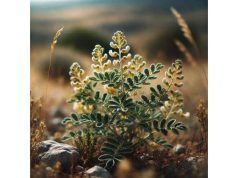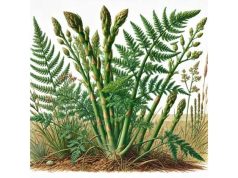
Ailanthus is a genus of fast-growing, deciduous trees native to various parts of Asia. Among its species, the most recognized is Ailanthus altissima, commonly called the “Tree of Heaven.” Initially admired for its rapid growth and ornamental appeal, this tree has spread widely across the globe, adapting well to urban and disturbed landscapes. Its compound leaves, comprising numerous leaflets, yield a distinctive musky odor when crushed, while its tall trunk and expansive canopy can dominate sites where it becomes established. In certain regions, Ailanthus altissima is considered invasive due to its vigorous reproduction and allelopathic influences—yet, in traditional medicine systems, the plant has also been valued for its supposed antimicrobial and anti-inflammatory properties.
Throughout history, Ailanthus has woven a complex tapestry: venerated in ancient Asian texts for potential therapeutic uses, utilized in reforestation and ornamental plantings, but later scrutinized for environmental impacts as it proliferated outside its home range. Researchers have identified a suite of phytochemicals in Ailanthus, including quassinoids and alkaloids, that may underpin various bioactivities such as controlling pests, defending against pathogens, and exhibiting mild medicinal actions. Despite concerns around invasiveness and certain toxins within the plant, its bark, leaves, and seeds remain of interest in herbal and pharmacological circles. This article explores Ailanthus’s storied past, chemical composition, and potential benefits and hazards in depth.
- Rapid growth and hardiness in challenging environments
- Traditional usage in Asian herbal medicine for mild infections or inflammatory conditions
- Potential pest-control and antimicrobial actions, linked to unique phytochemicals
- Concern over invasive spread, affecting local ecosystems and native plant communities
- Toxicity warnings regarding bark, sap, and seeds in both human and animal contexts
Table of Contents
- Ailanthus: Botanical Overview and Species Characteristics
- Ailanthus: Historical Context and Cultural Legacy
- Ailanthus: Notable Chemical Components and Phytochemicals
- Ailanthus: Potential Health Benefits and Traditional Properties
- Ailanthus: Practical Uses, Preparations, and Important Safety Measures
- Ailanthus: Significant Studies and Recent Scientific Findings
- Ailanthus: Frequently Asked Questions
Ailanthus: Botanical Overview and Species Characteristics
Taxonomy and Family
Ailanthus belongs to the Simaroubaceae family, a group of mostly tropical trees and shrubs recognized for their bitter-tasting compounds and insect-repelling properties. The genus Ailanthus encompasses several species, but Ailanthus altissima, the “Tree of Heaven,” is by far the most widespread and studied, particularly in temperate zones. Common synonyms and local names reflect its rapid colonizing nature, including Chinese sumac, copal tree, stinking sumac, and paradise tree.
Origin and Global Distribution
- Native Range
- Ailanthus altissima originated in parts of China, possibly central to northern regions, thriving in rocky or disturbed soils.
- Early descriptions in Chinese texts highlight its role in local herbal traditions, ornamental plantings, and silkworm cultivation (some references mention certain insects feeding on Ailanthus leaves).
- Spread to Other Continents
- Introduced to Europe in the 18th century as an ornamental curiosity. Its exotic flair and ability to survive pollution-laden cityscapes led horticulturists to plant it in avenues and public parks.
- Rapidly established in North America by the 19th century, used for shading newly built streets, thanks to its tolerance of poor soils and minimal care.
- Current Range
- Now found across every inhabited continent, especially in urban or industrial zones. It thrives in cracks of pavement, disturbed farmland, or neglected lots, frequently outcompeting native vegetation.
Physical Description
- Size and Growth
- Tree of Heaven can reach 15–25 meters (50–80 feet) tall, with a trunk diameter often exceeding 1 meter in mature specimens.
- Growth rates are notoriously high—saplings can gain over a meter of height annually in ideal conditions.
- Leaves and Leaflets
- Leaves are large and pinnately compound, ranging from 30 to 90 centimeters in length, containing 10–40 leaflets.
- Each leaflet typically features one or more glandular teeth near the base. Crushing them releases a pungent odor likened to rancid peanut butter or spoiled nuts.
- Flowers and Seeds
- Blooms in late spring or early summer. Male and female flowers often occur on separate trees, forming panicles near branch tips.
- Seeds mature into samaras (winged seeds) that turn red or pinkish before browning, often persisting on branches into winter, aiding wind dispersal.
- Bark and Wood
- Young bark is smooth and grayish-green, maturing into rough, fissured textures with age.
- The wood is coarse and brittle, with limited commercial timber value, though occasionally used in furniture or minor craft.
Ecological Behavior and Impact
- Invasive Dynamics:
Ailanthus altissima’s prolific seed production, vigorous stump sprouting, and allelopathic chemicals hamper neighboring plants. This can drastically shift native ecosystems and degrade biodiversity. - Resilience:
Highly tolerant of pollution, drought, and poor soil fertility, enabling it to flourish in cityscapes and brownfield sites.
Taxonomical Relatives
Other species in Ailanthus include:
- Ailanthus excelsa: Native to India, used in local pharmacopoeia for its bark’s medicinal qualities.
- Ailanthus vilmoriniana: Less common, occasionally grown as an ornamental in botanical collections.
Overall, the genus’s hallmark is a hardy, rapidly spreading growth habit, which, while lauded historically for landscaping and certain medicinal uses, has also caused ecological challenges in non-native locales.
Ailanthus: Historical Context and Cultural Legacy
Ailanthus altissima’s unusual combination of ornamental charm, utilitarian wood, and medicinal speculation has fostered a rich historical narrative that extends from ancient China to modern-day worldwide.
Ancient Asian Heritage
- Chinese Herbal Traditions:
- Ailanthus altissima is sometimes cited in historical Chinese medical texts, with bark extracts purportedly used to address intestinal worms, dysentery, or other complaints.
- Leaves have also been tested as feed for certain silkworm species, though less commonly than mulberry.
- Symbolic Connotations:
- Rare references speak of the “Tree of Heaven” as signifying resilience or abundant growth, linking to its capacity to survive harsh conditions.
Introduction to Europe
- 18th-Century Ornamental Craze:
Eager horticulturists, intrigued by the exotic, introduced Ailanthus to botanical gardens. By the late 1700s, it was used in street plantings, admired for rapid shade creation. - French and British Gardens:
Both countries found it appealing for grand estates, though it quickly spread beyond intended boundaries in milder climates.
North American Adoption
- Colonial Era Onward:
- Earliest U.S. arrivals date to Philadelphia’s horticultural circles in the late 18th century. By the 19th century, city planners across the Northeast planted it to line avenues, especially in industrial districts.
- Frontier Regions:
- As settlers moved west, some brought seeds or cuttings, seeing the tree’s drought tolerance as beneficial for homesteads.
- From Welcome Guest to Unwanted Invader:
- Over time, the species’ allelopathy and rampant seeding overshadowed its utility, transforming it into a persistent weed in urban vacant lots and rural farmland edges.
Cultural Footprints in Literature and Media
- Reference in Modern Works:
Betty Smith’s classic novel “A Tree Grows in Brooklyn” famously spotlights Ailanthus as a metaphor for resilience in impoverished cityscapes. - Urban Folklore:
Nicknamed “ghetto palm,” “stink tree,” or “tree-of-hell” in some communities, referencing both its unstoppable spread and pungent odor from crushed leaves.
Economic and Industrial Past
- Wood Usage:
Historically overshadowed by oak or pine, Ailanthus wood sometimes found minor use in cheap furniture or packaging crates. Its brittleness and unpleasant smell limited broader acceptance. - Resin or Medicinal Bark Trade:
In certain Asian contexts, bark or root extracts formed part of local commerce, albeit overshadowed by more recognized herbs like ginseng or astragalus.
Present-Day Perceptions
- Urban “Wilding” Icon:
Many city dwellers see Ailanthus as a scrappy emblem of nature’s resilience—sprouting from cracks in sidewalks or deserted building lots. Others regard it as a nuisance weed. - Ongoing Conflict:
Environmental agencies may attempt eradication to conserve native plant habitats, while some herbal practitioners champion select medicinal uses. The tension embodies the dichotomy of a plant labeled simultaneously as “heavenly” and “invasive.”
In short, Ailanthus’s cultural journey weaves together aesthetics, practicality, and cautionary tales about ecological disruption. Its cameo in literature as a symbol of urban grit underscores how deeply it has embedded itself into human narratives—both revered and reviled, beneficial yet problematic.
Ailanthus: Notable Chemical Components and Phytochemicals
Ailanthus altissima stands out among invasive trees due to its unique phytochemical repertoire. These compounds underpin many of the plant’s potential uses (and misuses), from insecticidal properties to prospective medicinal effects.
Quassinoids
- Ailanthone:
- One of the most studied quassinoids in Ailanthus. It exhibits insecticidal, antifeedant, and potential anticancer properties in laboratory settings.
- High concentrations in bark and seeds: a reason for caution, as ingestion by livestock or humans can be toxic.
- Neo-Quassin, Brucein-Like Compounds:
- Additional quassinoids with similar structural features to those found in Quassia amara.
- Typically bitter to taste, and bitterness often correlates with insecticidal or antibiotic activity.
Alkaloids
- A small range of alkaloid-like molecules have been detected, though less intensively researched than the quassinoids. Some references mention possible contributions to Ailanthus’s bitterness and potential neurological effects if consumed in large amounts.
Tannins and Phenolics
- Tannins:
- Contribute mild astringent properties, possibly explaining certain uses in folk medicine for dysentery or external wound cleansing.
- Flavonoids, Phenolic Acids:
- Provide moderate antioxidant activity. The exact profile can vary with regional climate and soil conditions.
Volatile Oils
- Minimal Essential Oil Content:
Ailanthus leaves or bark rarely produce significant aromatic essential oil. The signature “strong odor” arises more from small organic acids or other compounds that degrade upon leaf crushing.
Allelopathic Substances
- Allelochemicals:
- Ailanthus is known to release chemicals into the soil that inhibit germination or growth of neighboring plants.
- Ailanthone is implicated as a primary agent in this phenomenon, giving Ailanthus a competitive edge.
Toxicity Considerations
- Toxic Seeds and Bark:
- Seeds or bark ingestion can lead to adverse effects in mammals, including humans. Reports range from gastrointestinal upset to possible neurological symptoms in extreme cases.
- Skin Irritation:
- Sap from broken branches or crushed leaves can irritate the skin for some individuals, highlighting the need for gloves when handling.
Variation by Plant Part and Growth Stage
- Seeds and Bark:
High quassinoid concentration; historically targeted for potential pest control or minimal medicinal extracts. - Leaves:
Rich in bitter compounds, can cause contact dermatitis. - Roots:
Possibly contain the highest levels of ailanthone, fueling the plant’s ability to sprout from stumps or root fragments.
Extraction Techniques and Stability
- Alcoholic Tinctures or Aqueous Extracts:
Traditional herbal references mention soaking bark in alcohol or water. Prolonged steeping can yield potent solutions with insecticidal or medicinal potential. - Inconsistent Standardization:
Commercial herbal supplements from Ailanthus are rare or nonexistent in many regions due to concerns over toxicity and limited established safety profiles.
Overall, Ailanthus’s phytochemical arsenal is a double-edged sword—granting both fascinating benefits (like pest control or prospective anticancer leads) and worrisome toxicities. Understanding these compounds fosters respect for the species’ potent biology and informs cautious usage.
Ailanthus: Potential Health Benefits and Traditional Properties
Despite its reputation as a troublesome weed or invasive tree, Ailanthus altissima also boasts a legacy of folk medicinal use—particularly in East Asia. While modern research remains limited compared to well-known herbs, some anecdotal and preliminary scientific evidence suggests health-related properties worth noting.
1. Antimicrobial and Insecticidal Effects
- Historical Pest Control:
- Farmers in certain parts of China would use bark or leaf extracts to deter insects from crops. Quassinoids like ailanthone function as antifeedants, halting pest infestations.
- Antimicrobial Indications:
- Some in vitro studies highlight moderate antibacterial or antifungal activity, presumably linked to quassinoids. Not robustly tested in clinical settings, so usage remains largely theoretical for now.
2. Gastrointestinal and Intestinal Health
- TCM (Traditional Chinese Medicine) Perspectives:
- “Chun Bai Pi” or “Chun Gen Pi” references the bark as a remedy for dysentery, diarrhea, or intestinal worms. The astringent, bitter nature might help reduce bowel overstimulation.
- Possible synergy with warming or carminative herbs when addressing gut infections or parasitic invasions.
3. Anti-Inflammatory and Fever Reduction
- Folk Claims:
- Bark decoctions have been used to lower mild fevers or reduce local inflammation, though potency is reportedly mild compared to more established antipyretic herbs.
- Mechanistic Hints:
- Laboratory experiments with ailanthone or related compounds show some suppression of inflammatory cytokines. While suggestive, human trials remain lacking.
4. Anti-Cancer Potential
- Quassinoid Research:
- Some academic interest in ailanthone focuses on potential cytotoxic effects against certain tumor cell lines.
- A 2020 study in the Journal of Ethnopharmacology discussed ailanthone inhibiting proliferation in cultured cancer cells, but real-world application is far from conclusive.
- Limitations:
- Toxic side effects pose significant hurdles. So far, no recognized mainstream cancer therapies revolve around Ailanthus derivatives.
5. Stimulating or Tonic Effects?
- Weak Allegations:
- Occasional references mention a mild energizing effect from small bark doses. Possibly from the bitter quassinoids stimulating digestion or metabolism.
- Very few documented experiences exist outside anecdotal claims, so any “tonic” effect remains speculative.
6. Wound Cleansing or External Wash
- Topical Folk Usage:
- Some local traditions included Ailanthus leaf or bark decoctions for external rinses on minor wounds or fungal infections.
- The bitterness and antibacterial potential might help disinfect or expedite healing, though no robust clinical validations confirm it.
Balanced Perspective on Health Claims
- Potential vs. Risk:
- While quassinoids exhibit notable bioactivity, toxicity is significant if consumed incorrectly. The line between beneficial and harmful can be narrow.
- Not a Mainstream Herb:
- Conventional herbal catalogs rarely highlight Ailanthus for everyday wellness, mainly due to safety concerns and overshadowing invasive implications.
- Strictly Supervised Use:
- In TCM contexts, use is typically performed under professional direction with precise dosing and formula synergy to mitigate toxicities.
In essence, Ailanthus’s potential health benefits revolve around potent quassinoid compounds that deliver insecticidal or antimicrobial properties, some ability to quell mild GI distress, and possible anticancer leads. However, the plant’s toxic profile demands caution, restricting its role in mainstream herbal practice and emphasizing the need for well-informed, carefully moderated usage.
Ailanthus: Practical Uses, Preparations, and Important Safety Measures
Practical and Historical Applications
- Insect Control:
- Traditional small-scale usage of bark/leaf extracts to ward off crop-eating pests, though overshadowed by modern pesticides.
- Potential for organic pest management strategies if refined to minimize environmental harm.
- Ornamental Planting:
- Once popular for shade in urban areas, but now discouraged in many regions due to invasive behavior and damage to infrastructure.
- Rarely used in contemporary ornamental horticulture except in specialized botanical displays or for research.
- Soil Erosion and Reclamation:
- The species’ robust root system is sometimes leveraged for stabilizing disturbed soils or mine tailings. However, the ecological trade-off is high risk of unstoppable invasion.
Medicinal Preparations and Formulations
- Bark Decoctions:
- Possibly employed in TCM-like contexts for GI issues. Bark is boiled in water for up to 20 minutes to draw out quassinoids.
- Highly bitter, requiring sweeteners or complementary herbs to offset taste.
- Risk of toxicity demands measured dosage, typically guided by a qualified herbalist.
- Powdered Bark or Leaf:
- Less common. If used, it may appear in carefully calibrated Chinese patent medicines, combined with other balancing herbs.
- Unregulated products can pose hazards—verifying authenticity and dosage is crucial.
- Topical Washes or Poultices:
- Historically used for minor skin complaints or infections. The user would steep bark or leaves, then apply cooled liquid to affected areas.
- Rare in modern herbal circles, overshadowed by safer or more extensively tested topical remedies.
Culinary Aspects
- Minimal Edible Use:
- Leaves and seeds contain toxic compounds; ingestion is generally discouraged.
- While some traditional gleanings mention limited usage in times of famine, it’s far from mainstream or recommended.
Invasive Management and Caution
- Handling and Harvesting:
- Wear gloves and protective clothing. The sap and bark can irritate skin and mucous membranes.
- Tools used to cut or remove Ailanthus can spread root fragments, promoting regrowth.
- Environmental Concerns:
- Resist planting or encouraging Ailanthus altissima in areas where it’s not native. Removing seedlings early is typically best.
- Disposal of cuttings must be managed carefully—composting might inadvertently spread viable seeds or roots.
Toxicity Warnings and Drug Interactions
- Poisonous Seeds:
- Seeds contain high concentrations of quassinoids, potentially lethal if consumed in quantity.
- Pets or livestock ingesting seeds can face severe complications, including neurological and organ distress.
- Allergenic Contact:
- Some individuals develop rashes or allergic reactions after contacting leaf sap or bark dust.
- Drug Interference:
- No extensive data, but strong bitter or alkaloid content can hamper medication absorption or intensify certain interactions.
- Anyone on prescription meds or with underlying medical conditions should consult professionals before exploring bark-based remedies.
General Guidelines for Safe Interaction
- Professional Supervision:
Using Ailanthus bark or extracts for medicinal ends is best done under a licensed practitioner, especially in TCM contexts. - Alternative Solutions:
For everyday health needs or insect control, safer, well-vetted herbs or methods typically exist. - Ecological Responsibility:
In locales where Ailanthus is invasive, physical removal or herbicidal approaches may be recommended to preserve native biodiversity.
In summary, while Ailanthus yields interesting chemical potentials and a notable place in certain traditional medicine systems, practical usage is complicated by toxicity, invasive tendencies, and limited research. Approaching the plant with respect—whether for horticultural or medicinal aims—ensures minimal ecological or health risks.
Ailanthus: Significant Studies and Recent Scientific Findings
Although overshadowed by widely embraced medicinal plants, Ailanthus altissima has drawn interest from botanists, ecologists, and pharmacologists. Below is a roundup of influential research highlighting the complexities and possibilities of Ailanthus.
1. Insecticidal and Anti-Pest Properties
- Study (2013), Industrial Crops and Products
Researchers investigated the insecticidal potential of Ailanthus bark extracts against key crop pests. Results indicated a strong antifeedant effect, aligning with traditional uses. Quassinoids, particularly ailanthone, were deemed crucial in deterring pests. - Conclusion: Suggests scope for botanical insecticides, but commercial viability remains hindered by toxicity concerns toward non-target species.
2. Cytotoxic Effects on Cancer Cells
- Research (2018), Journal of Ethnopharmacology
Lab-based tests assessed ailanthone’s influence on various tumor cell lines, noting significant inhibitory activity in certain leukemia and lung cancer cultures. The study emphasized caution, as normal cell lines also displayed sensitivity, reflecting a narrow therapeutic window. - Implication: A potential anticancer lead molecule if refined, but toxic side effects hamper immediate clinical usage.
3. Allelopathic Mechanisms
- Paper (2020), Plant Ecology & Diversity
Explored how root exudates from Ailanthus altissima hinder the germination of native understory plants. Ailanthone and related substances stunted competitor species, explaining the tree’s invasive dominance. - Environmental Notion: Reinforces calls for early removal in biodiversity hotspots to prevent further ecosystem imbalance.
4. Metabolite Profiling for TCM
- Study (2019), Chinese Journal of Integrative Medicine
Focused on TCM formulations containing Ailanthus altissima bark. LC-MS/MS methods identified quassinoid fingerprints at various extraction stages. Preliminary results highlight consistent markers that might help standardize “Chun Bai Pi”-based remedies. - Relevance: Encourages quality control in TCM to ensure safe, reliable usage.
5. Environmental Resilience and Phytoremediation
- Review (2021), International Journal of Environmental Research
Summarized Ailanthus’s rapid colonization in polluted soils or metal-contaminated lands. The species demonstrates potential for certain phytoremediation strategies, extracting or stabilizing heavy metals. - Caveat: Widespread planting for remediation must consider the tree’s invasive risk. Additional oversight or post-project removal might be necessary.
Ailanthus: Frequently Asked Questions
Is Ailanthus altissima really poisonous, or just problematic for the environment?
While Ailanthus altissima is primarily recognized for ecological concerns, it also contains chemicals that can be toxic if consumed in large amounts. The bark, seeds, and sap contain quassinoids linked to adverse effects in humans and animals. Caution is advised when handling or using Ailanthus in any medicinal context.
Can Ailanthus be safely used in herbal medicine?
Some traditional applications exist in Chinese medicine for bark extracts, but the margin between beneficial doses and toxicity is narrow. Self-treatment with Ailanthus is risky without professional guidance. Many herbal experts steer clear of it, opting for gentler, better-researched alternatives.
How can I control or remove an unwanted Ailanthus tree?
Eliminating Ailanthus often requires cutting the trunk near ground level and subsequently treating the stump or new sprouts with systemic herbicides. The tree’s root suckers are extensive, so repeated efforts or professional invasive-species removal services may be needed to prevent regrowth.
Is there any productive use for Ailanthus wood or biomass?
Historically, the wood found limited use in crafting low-end furniture or crates. Some new research explores the potential for biofuel or phytoremediation thanks to Ailanthus’s fast growth. However, the risk of spreading seeds or roots typically curtails large-scale industrial usage in many regions.
Disclaimer:
The information presented here is intended for educational purposes only and should not be construed as medical advice. Always seek qualified professional counsel before using invasive or potentially toxic plants in any remedy, whether for health or environmental management.
If you found this article on Ailanthus helpful, please share it on Facebook, X (formerly Twitter), or your favorite social media platforms. Spreading knowledge empowers others to learn about this fascinating yet controversial tree!










